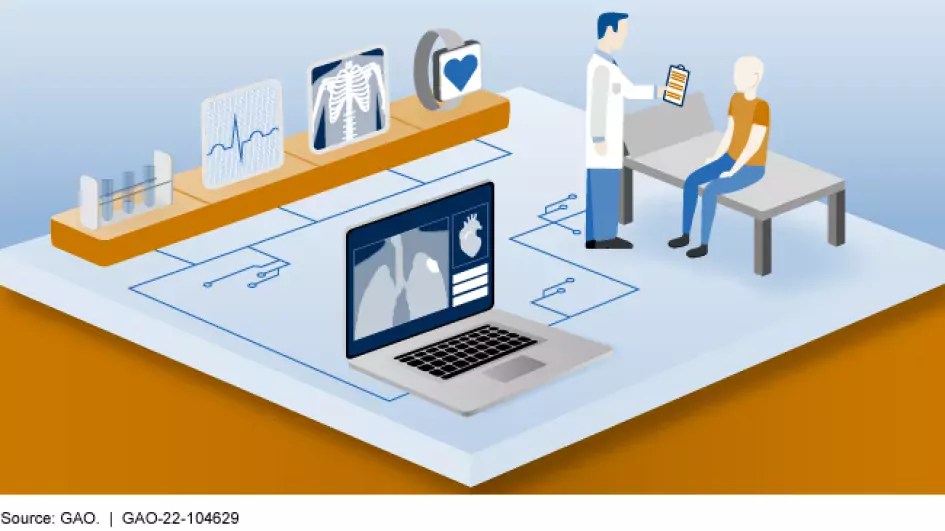Machine Learning’s Potential to Improve Medical Diagnosis
Diagnostic errors are some of the most common, catastrophic, and costly of medical errors, according to the Society to Improve Diagnosis in Medicine. It also estimates that errors affect the more than 12 million Americans each year, with associated costs likely in excess of $100 billion. Accurate medical diagnosis is a critical first step in patient care, and significantly improves a patient’s overall chance for positive health outcomes.
In recent years, machine learning—a type of artificial intelligence (AI)—has emerged as a powerful tool for improving medical diagnosis. Machine learning technologies are trained to identify patterns that may be hidden or complex. For example, after providing a computer with large amounts of data, machine learning can identify structure and patterns in the data. Then it can use those patterns to predict answers to problems, or cluster information into useful groups for comparison, such as similar images of cancerous lesions. Machine learning can also be used to identify patterns that may be hidden or complex, such as the details within the imagery of x-rays, ultrasounds, and magnetic resonance imaging (MRI).
Today’s WatchBlog post looks at our recent work on the use of machine learning to provide new capabilities in medical diagnostics, as well as some of the challenges this technology faces in gaining widespread use.
Image

How could machine learning affect medical diagnosis?
While still in the early stages of implementation, machine learning has the potential to provide more accuracy in diagnostic results, as well as saving time and money, and most importantly, saving lives.
For example, machine learning could detect diseases earlier. Six in 10 Americans live with at least once chronic condition, such as cancer or heart disease. Machine learning is capable of aiding in cancer diagnosis by using data from medical imagery to detect, measure, and analyze tumors. Applying its advantage in computing power to conduct data and imagery analysis more quickly than human medical professionals are able to on their own, machine learning could complete screenings in less time. This could reduce referral wait times for high-risk patients, and lessen the burden on clinics that face short staffing or other challenges.
Machine learning technologies could also improve consistency and accuracy of diagnosis by removing situations that contribute to human error. For example, human specialists that perform diagnosis are affected by factors such as fatigue and can vary in their interpretation of data and imagery.
Machine learning could also broaden health care access. Some regions and populations in the United States have limited access to medical professionals. This emerging technology could automate certain tasks, which in turn could reduce clinical workloads and empower non-specialists to perform complicated tasks, such as cardiac imaging and analysis. This could allow medical professionals to reach larger segments of the population in at-home care or smaller clinical settings, and provide more patients with access to care.
How widespread is machine learning in health care and what could limit its use?
Several machine learning technologies are in use by medical professionals in the United States, with most technologies relying on data from imaging such as x-rays or MRIs. Our recent work looked at how machine learning was being used to diagnose five common diseases—certain cancers, diabetic retinopathy, Alzheimer’s disease, heart disease, and COVID-19. Cancer was the most common current application relying on imaging, and machine learning was being used to help detect, measure, and analyze tumors and lesions.
While researchers continue to expand AI and machine learning capabilities in medical diagnostics, these technologies have generally not been widely adopted and face a number of challenges limiting more widespread use. For example, some medical providers may be reluctant to use machine learning in their clinics until its performance is more widely proven in diverse clinical settings. A lack of familiarity among some medical professionals about how machine learning would fit within and enhance their workflow, along with gaps in regulatory guidance and requirements, and the cost of implementation and maintenance, may also limit its development and use.
Our recent report details these challenges and offers some policy options for lawmakers to consider. These include policies to encourage or require the evaluation of machine learning diagnostic technologies across a range of real-world settings, expand access to high-quality medical data, and promote collaboration between developers, providers, and regulators. Learn more about machine learning and AI in medical diagnostics by checking out our report.
- Comments on GAO’s WatchBlog? Contact blog@gao.gov.
GAO Contacts
Related Products

GAO's mission is to provide Congress with fact-based, nonpartisan information that can help improve federal government performance and ensure accountability for the benefit of the American people. GAO launched its WatchBlog in January, 2014, as part of its continuing effort to reach its audiences—Congress and the American people—where they are currently looking for information.
The blog format allows GAO to provide a little more context about its work than it can offer on its other social media platforms. Posts will tie GAO work to current events and the news; show how GAO’s work is affecting agencies or legislation; highlight reports, testimonies, and issue areas where GAO does work; and provide information about GAO itself, among other things.
Please send any feedback on GAO's WatchBlog to blog@gao.gov.




